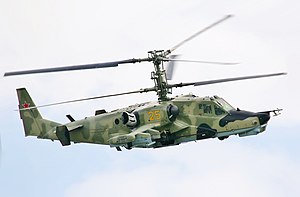Ka-52
| Ka-50 "Black Shark" Ka-52 "Alligator" |
|
|---|---|
 |
|
| Kamov Ka-50 of the Russian Air Force (VVS) | |
| Role | Attack helicopter,scout helicopter |
| National origin | Soviet Union / Russia |
| Manufacturer | Kamov |
| First flight | Ka-50: 17 June 1982 Ka-52: 25 June 1997 |
| Introduction | 28 August 1995 |
| Status | In service |
| Primary users |
Russian Air Force (VVS) Egyptian Air Force |
| Produced | 1990-present |
| Number built | Ka-50: 32 Ka-52: 80 |
| Unit cost |
500 million rubles (approx. $16 million) as of May 2011
|
| Developed from | Kamov V-80 |
The Kamov Ka-50 "Black Shark" (Russian: Чёрная акула; Chornaya Akula, NATO reporting name: Hokum A) is a single-seat Russian attack helicopter with the distinctive coaxial rotor system of the Kamov design bureau. It was designed in the 1980s and adopted for service in the Russian army in 1995. It is manufactured by the Progress company in Arsenyev. It is being used as a heavily armed scout helicopter.
During the late 1990s, Kamov and Israel Aerospace Industries developed a tandem-seat cockpit version, the Kamov Ka-50-2 "Erdogan", to compete in Turkey's attack helicopter competition. Kamov also designed another two-seat variant, the Kamov Ka-52 "Alligator" (Russian: Аллигатор, NATO reporting name: Hokum B).
The Ka-50 is the production version of the V-80Sh-1 prototype. Production of the attack helicopter was ordered by the Soviet Council of Ministers on 14 December 1987. Development of the helicopter was first reported in the West in 1984. The first photograph appeared in 1989. During operational testing from 1985 to 1986, the workload on the pilot was found to be similar to that of a fighter-bomber pilot, such that the pilot could perform both flying and navigation duties.
Like other Kamov helicopters, it features Kamov's characteristic contra-rotating co-axial rotor system, which removes the need for the entire tail rotor assembly and improves the aircraft's aerobatic qualities—it can perform loops, rolls and "the funnel" (circle-strafing), where the aircraft maintains a line-of-sight to the target while flying circles of varying altitude, elevation and airspeed around it. The omission of the tail rotor is a qualitative advantage, because the torque-countering tail rotor can use up to 30% of engine power. The Ka-50's entire transmission presents a comparatively small target to ground fire.
...
Wikipedia
